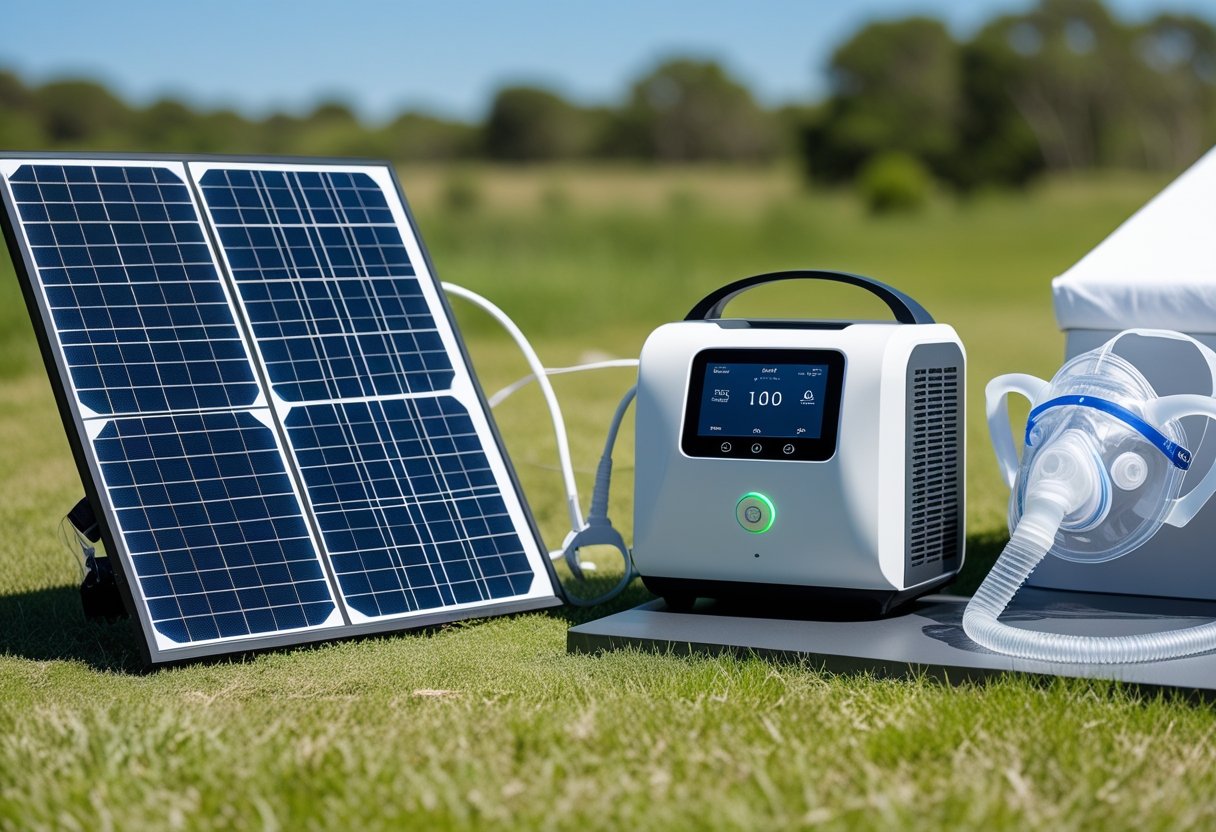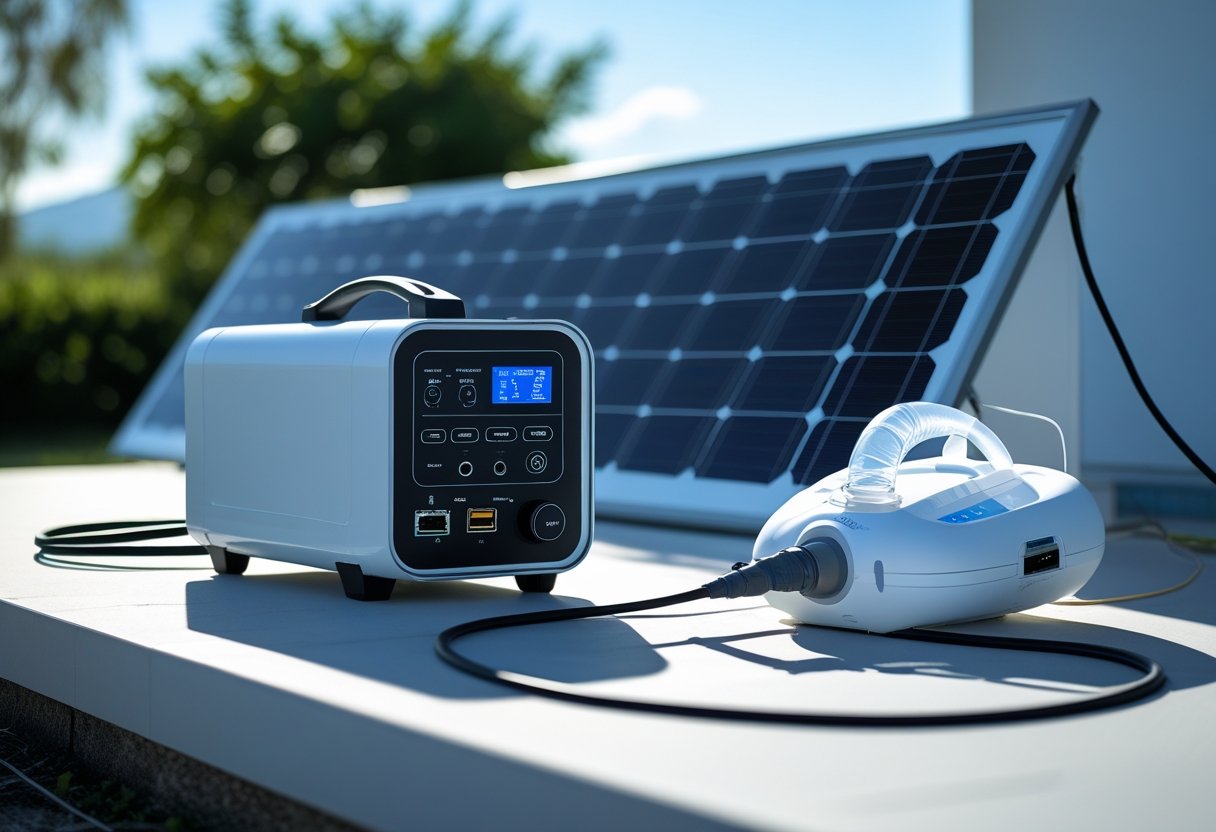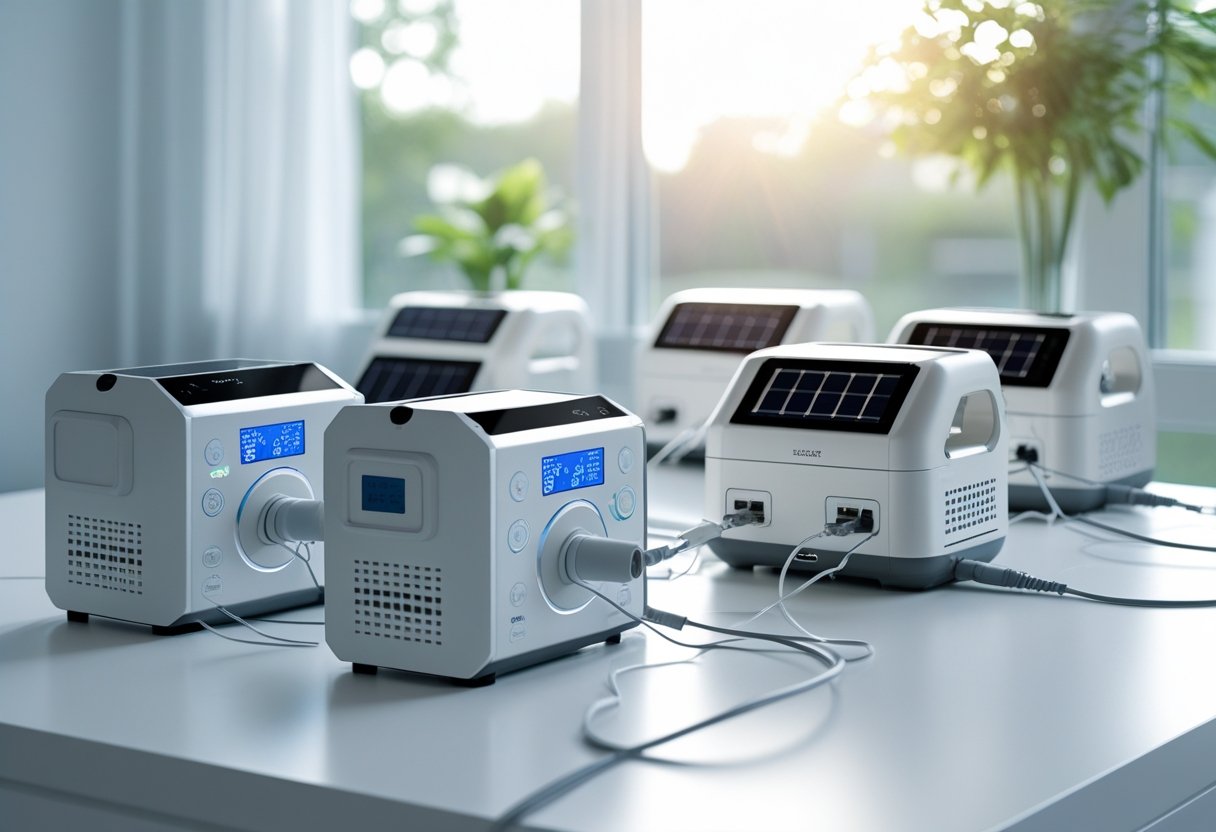Using a reliable power source is crucial for CPAP machines, especially during power outages or outdoor activities. Solar generators are an effective solution, providing portable, clean energy to keep these devices running without interruption. They combine convenience with sustainability, making them ideal for users who need consistent power on the go.

The top solar generators for CPAP machines deliver stable, quiet, and efficient power that ensures the machine operates safely throughout the night. Models like the Anker 767 and Bluetti AC50S are designed to support sensitive electronics while offering hours of continuous use. Selecting the right generator depends on capacity, output type, and portability.
Understanding the key features and performance of various solar generators helps users make informed decisions. This guide highlights the best options available in 2025, focusing on compatibility with CPAP needs and overall reliability for different situations. For detailed reviews, see the collection of top solar-powered generators tested and reviewed by Outdoor Life and Good Housekeeping.
Understanding Solar Generators for CPAP Machines
Solar generators provide a reliable source of power, especially where grid electricity is unavailable or inconsistent. When used with CPAP machines, understanding how they function and the device’s specific power needs is vital. The use of solar energy also offers practical benefits for maintaining uninterrupted therapy.
How Solar Generators Work
A solar generator uses photovoltaic (PV) panels to convert sunlight into electrical energy. This energy is stored in a built-in battery power system. When the CPAP machine operates, it draws power from this battery.
The typical components include:
- Solar panels that collect sunlight
- Battery storage for energy reserve
- Inverter to convert DC to AC power if the CPAP requires it
Because CPAP machines are sensitive medical equipment, the generator must provide a stable and clean power output. Some models, like the Anker 767, are specifically recommended for sensitive electronics due to their consistent voltage regulation.
CPAP Power Requirements
A CPAP machine generally uses around 30 to 60 watts during operation, but power consumption varies by model and features such as heated humidifiers.
To run a CPAP continuously for 12 hours, a solar generator needs enough watt-hours (Wh) or amp-hours (Ah) to cover this demand. For example, a machine drawing 6.67 amps at 12 volts would require approximately 80 watt-hours per hour, so a generator should support roughly 1000+ Wh for a full night’s use.
Voltage stability and surge protection are critical because fluctuations can damage the CPAP or interrupt therapy. Users should check their machine’s specifications before choosing a solar generator to ensure compatibility.
Benefits of Solar Energy for Medical Devices
Solar energy offers independence from the grid, which is essential during power outages or in remote locations. It enables continuous CPAP use without relying on conventional power sources.
Key benefits include:
- Portability, suitable for travel or camping
- Quiet operation, avoiding noise that could disrupt sleep apnea therapy
- Clean energy, reducing environmental impact
- Cost savings over time by eliminating fuel or electricity expenses
Solar generators designed for medical equipment provide a safer, more reliable solution for users who depend on uninterrupted CPAP operation. Using solar energy also aligns with sustainable health practices by minimizing fossil fuel dependence.
Learn more about solar generators suitable for CPAP machines at Anker’s guide on solar generators for CPAP machines.
Key Features to Consider When Choosing a Solar Generator

Choosing a solar generator for a CPAP machine requires attention to specific technical aspects. Battery performance, ease of transport, and power conversion quality all directly impact the reliability and safety of the device.
Battery Backup and Capacity
Battery backup is crucial because it defines how long a CPAP machine can run during power outages or off-grid situations. Most CPAP machines need continuous power for 6–8 hours overnight. Lithium batteries are preferred for their high energy density, longer lifespan, and lighter weight compared to lead-acid alternatives.
Capacity is measured in watt-hours (Wh). A typical CPAP consumes between 30 to 60 watts, so a battery capacity of at least 200 Wh ensures a full night’s operation. Users should look for solar generators with clear battery specifications and ideally those that can be charged via both solar panels and AC outlets for flexibility.
Portability and Weight
Portability matters because users often carry solar generators between locations or need a compact model for travel. Lightweight but durable designs make it easier to handle and set up the generator near the CPAP device.
Portable power stations under 15 pounds offer a good balance between battery capacity and ease of transport. Features such as carrying handles, rugged casing, and compact size enhance portability. However, very small generators may lack sufficient runtime, so users need to check weight against battery capacity to find an optimal fit.
Inverter Technology
Inverter quality affects the safety and compatibility of the power supply with sensitive electronics like CPAP machines. Pure sine wave inverters provide clean, stable electricity similar to household outlets, which helps protect the CPAP device’s motor and electronics.
Solar generators with modified sine wave inverters are cheaper but can cause noise, overheating, or shortened device lifespan. It is advisable to prioritize models with pure sine wave inverters and wattage ratings exceeding the CPAP’s startup power to avoid power interruptions or failures.
Top Solar Generators for CPAP Machines on the Market

Solar generators designed for CPAP machines must balance power output, runtime, and portability. Key products offer reliable pure sine wave AC outlets for sensitive medical equipment and enough battery capacity to run CPAP devices overnight or longer.
Goal Zero Yeti Series
The Goal Zero Yeti series is a popular choice for CPAP users due to its consistent power delivery and flexibility. Models like the Yeti 500X and Yeti 1000X provide between 480Wh and 1045Wh battery capacity. This supports CPAP machines for 8 to 16 hours depending on the model and settings.
They include pure sine wave inverters, essential for safe CPAP operation. Multiple output ports, including USB-C, 12V, and AC, allow for charging other devices during use. Their compact design and rugged build make them suitable for camping or emergency power backup.
Solar panel compatibility is strong, offering quick recharge when paired with Goal Zero’s solar panels. This series is highly rated for dependable power without noise or emissions.
EcoFlow Delta Models
EcoFlow Delta models are known for high-capacity batteries and fast recharge speeds. The Delta 1300 and Delta Max provide 1260Wh to over 2000Wh of power, sufficient for running CPAP machines up to 24 hours or longer.
The built-in X-Stream technology enables recharging to 80% in about an hour, minimizing downtime. Pure sine wave output ensures CPAP machines operate safely without interference.
The Delta series supports multiple solar panel inputs, making them well-suited for extended off-grid use. Their digital displays give clear information on power status and runtime. Though slightly heavier than some competitors, their capacity and advanced features make them strong options for CPAP users seeking longer backup power.
Other Recommended Portable Power Stations
Several other portable power stations work well with CPAP machines. The ALLWEI Portable Power Station 300W offers a light, budget-friendly option with 280Wh capacity. It’s good for shorter-term use or travel.
Bluetti and Jackery also make reliable solar generators with pure sine wave output and adequate battery sizes ranging from 500Wh to over 1000Wh. These brands provide a good balance of portability, power, and solar recharge capabilities.
When choosing, focus on continuous power output specs (ideally 200W or higher) and compatible AC outlets. Portability and recharge options via solar or wall also factor into ease of use.
Comparing Solar Generators for CPAP
| Feature | Goal Zero Yeti Series | EcoFlow Delta Models | Other Portable Stations |
|---|---|---|---|
| Battery Capacity | 480Wh to 1045Wh | 1260Wh to 2016Wh | 280Wh to 1000Wh |
| Pure Sine Wave Output | Yes | Yes | Usually, but confirm model |
| AC Output (Continuous) | 300W – 1500W depending on model | 1800W – 2200W | 300W and up |
| Weight | Moderate (12-30 lbs) | Heavier (30-48 lbs) | Lightweight to moderate |
| Recharge Speed | Moderate with solar | Fast (X-Stream tech) | Varies |
| Recommended For | Reliable, portable use | High capacity, fast recharge | Budget travel or shorter use |
Choosing the right solar generator for CPAP depends on how long power is needed and the weight a user is willing to carry. High-capacity models excel in long-term use, while lighter models suit occasional travel or emergency backup.
Using Solar Generators in Real-Life Scenarios
Solar generators provide reliable, portable power solutions that support critical devices like CPAP machines during various conditions. Their ability to operate silently and without fumes makes them especially valuable when traditional power sources fail or are unavailable.
Emergency Situations and Power Outages
During power outages, solar generators enable continuous operation of CPAP machines without interruption. They convert solar energy into electrical power, eliminating dependence on unstable grid power or noisy fuel generators. This makes them a crucial backup during emergencies like storms or blackouts.
A typical 500-watt solar generator can run a 40-watt CPAP machine for several hours, covering a full night’s use. Proper solar panel capacity is essential to recharge the generator during the day. Their quiet operation and fume-free power make solar generators safe for indoor use in emergency scenarios.
Camping and Outdoor Adventures
When camping or off the grid, solar generators allow users to maintain therapy routines without heavy batteries or fuel. Lightweight and portable, these devices charge through sunlight, making them suitable for extended outdoor trips where power sources are absent.
Users should choose a generator with enough wattage to support the CPAP machine’s continuous power needs. Solar kits designed for camping often include foldable panels for easy transport and efficient charging. This setup ensures CPAP use does not interrupt natural outdoor experiences.
Supporting Oxygen Concentrators and Additional Medical Equipment
Solar generators are valuable for powering oxygen concentrators and other medical devices alongside CPAP machines. Since oxygen concentrators typically require higher wattage, selecting a generator with sufficient capacity is critical.
Those relying on multiple devices should assess total power requirements carefully. Solar generators’ silent, clean energy makes them suitable for indoor medical use, avoiding emissions that fuel generators produce. This ensures uninterrupted support for critical health equipment in various settings.
For more detailed information on powering CPAP and medical devices with solar generators, refer to Jackery’s guide on CPAP Power Supply with Solar Generators.
Top Pick: Jackery Explorer 1000
Reliable, portable, and powerful — ideal for blackouts, camping, and off-grid living.
Check Price on Amazon →